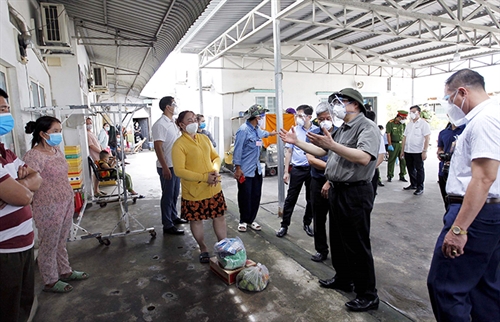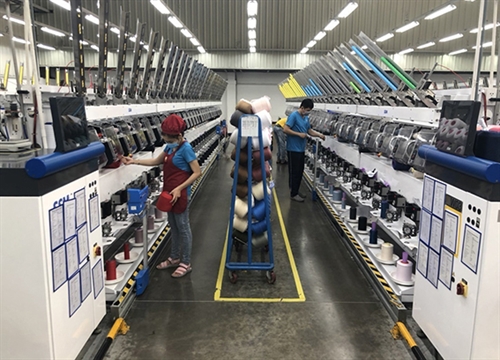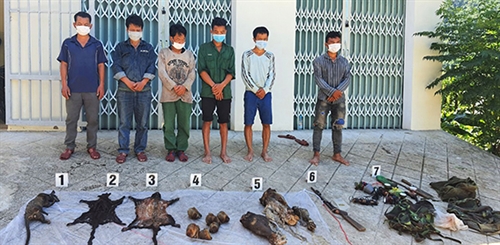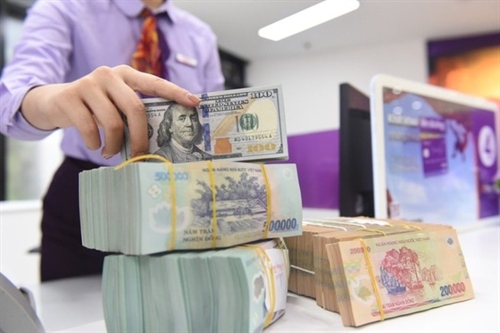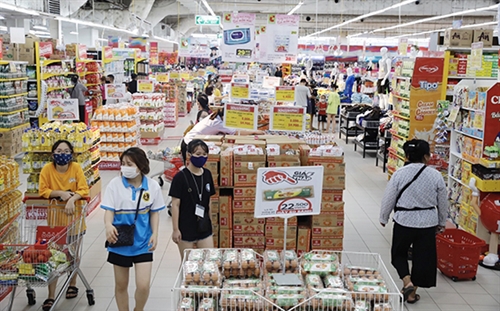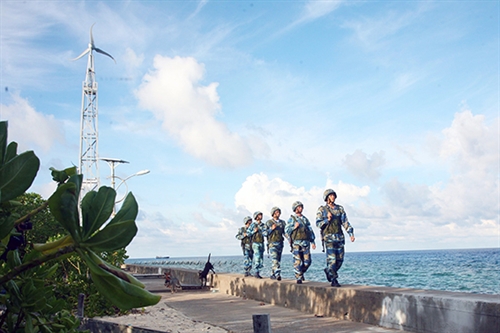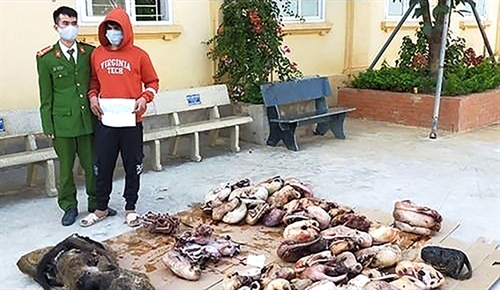In order to materialize the goal of making Vietnam a strong marine nation, a renewed and breakthrough way of thinking is required to swim with the common global trend of sustainable development and harmony between marine development and conservation, aiming to address such issues as transnational environmental pollution and climate change…, with the building of a blue economy as the foundation. Blue economy, albeit having been discussed in Vietnam for a while, remains a rather new concept in terms of both content and approach, especially the assessment of the current situation and potential for development of such economy in the country.
PhD. Nguyen Dinh Dap[2] and Doan Thi Hong Hanh[3]
New approach in the development of marine economy
Blue economy means the assurance of sustainable marine livelihoods and higher income for people, rational exploitation of natural resources with fewer environmental impacts, and construction and development of infrastructure adaptable to climate change and extreme weather.
The 2015 World Ocean Summit put forth the concept of blue economy, which is a sustainably developed marine economy where marine economic activities balance with the constant supply capacity of marine ecological systems.
Therefore, a blue economy both ensures the economic development and the development of marine ecological systems by such modes as reduction of carbon emissions, intensive growth, natural resources conservation, and environmental friendliness. The development of a blue economy clearly demonstrates the role of conservation and sustainable development of marine ecosystems or also called ecosystem development.
Opportunities for development of Vietnam’s blue economy
Vietnam has an advantage in sea transport as it is situated near international and regional maritime routes. Vietnam’s sea lies in the region with high economic growth rates and serves as a bridge between many economic and political powers in the world. These are favorable conditions for Vietnam to develop its maritime sector, shipbuilding and logistics industries, given its 114 estuaries, 52 deep-sea gulfs along the central coast (gulfs, bays and lagoons stretching over 60 percent of the coastline), and over 100 positions for construction of big seaports.
Vietnam’s sea contains about 35 minerals of various groups: fuel, metal, building materials, precious and semi-precious stones, and liquid minerals. Construction sand mines under the sea beds in Quang Ninh province and Hai Phong city have a deposit of over 100 billion tons and a quartz sand stretch under Quang Ninh seabed has a deposit of nearly 9 billion tons. Besides, the potential of seawater resources is great with diverse types of marine energy such as natural hydrate, tidal energy, wave energy, heavy-water nuclear energy.
Vietnam’s sea is also rich in marine resources. Apart from fishes, a major resource, there are many specialties of high economic value such as shrimps, crabs, sea cucumbers, seaweed, etc. For fishes alone, more than 2,000 species have been discovered, including some 100 of economic value; there are 15 vast fishing grounds most of which are located near the coast. The fish deposit in Vietnam’s sea area approximates 5 million tons/year, the annual fish catch is around 2.3 million tons.
The 3,260 km-long coastline and thousands of islands constitute favorable conditions for Vietnam to develop sea tourism. Along its coast, there exist about 125 beautiful beaches, some ranked as the best in the world.
Vietnam’s sea lies in a tropical climatic zone with many parts enjoying a lot of sunshine around the year, very ideal for tourists from many countries, especially those with cold winters. In the recent years, Vietnam’s sea and island tourism has vigorously developed, attracting increasing numbers of domestic and international tourists.
Together with the existing potentials for development of a blue economy, Vietnam also has a number of favorable conditions.
It has launched many strategies and policies to transition its economy from a “brown” to “green” one, including the national strategy on green growth up to 2020; the strategy on sustainable exploitation and use of marine resources and protection of marine environment up to 2020, with a vision toward 2030, among others; and made many international commitments on environment and development.
Vietnam has approved a number of laws, master plans and plans for deployment of green growth tasks, such as the national plan of action on green growth for the 2014-2020 period, the 2012 Law of the Sea of Vietnam, the 2015 Law on Marine and Island Resources and Environment. The national sea space planning has been incorporated in the 2017 Law on Planning.
Resources to support the building of a marine economy of Vietnam are also diverse and considerable, including human, financial, material and intellectual resources. Proper attention has been paid to the development of physical-technical foundations and infrastructure for development of the marine economy as well as the protection of marine environment and conservation.
The country is strongly determined to reform and restructure its economy, with importance being attached to the marine economy and international integration in this field.
Solutions to building a blue economy of Vietnam
The Party Central Committee’s Resolution 36-NQ/TW of October 22, 2018, on the Strategy on sustainable development of Vietnam’s marine economy to 2030, with a vision towards 2045, states that by 2030, the marine economic sectors will be developed with success and breakthroughs in the following priority order: sea tourism and services; maritime economy; exploitation of petroleum and other marine minerals; marine resource farming and exploitation; coastal industries; renewable energy and new marine economic sectors. It can be observed that resource-intensive economic sectors have been given lower priority and replaced by natural resource-saving ones such as tourism and maritime industry.
The nouveaux of the Strategy is the inclusion of the marine resource farming besides exploitation. Moreover, it lists the renewable energy industry and new marine economic sectors, such as wind power, on-sea solar power, sea-tide power, exploitation of marine bio-diversity resources (marine pharmaceuticals, seaweed growth and processing), etc. These sectors either save natural resources or use renewable ones. The new marine economic sectors have high scientific and technological content directed toward sustainable development. This is a breakthrough of the Strategy on sustainable
development of Vietnam’s marine economy towards a blue economy. In order to materialize this Strategy, efforts should be concentrated on the application of a number of solutions.
For sea tourism and services, to attach importance to investment in tourist infrastructure. To encourage and create favorable conditions for all economic sectors to participate in developing eco-tourism, scientific exploration, community tourism, high-quality tourist resorts in coastal areas; to build, develop and diversify sea tourism products, product chains and brands of international ranking on the basis of conservation of bio-diversity, promotion of values of distinctive natural, cultural, historical heritages of different regions and zones, connection with international tourist routes for Vietnam to be an attractive destination of the world. To experimentally develop tourism in islands and offshore areas, enhance search, rescue and salvage capability, step up scientific exploration activities and promote sea education and health. To support coastal inhabitants to change their occupations from activities that cause harms and negative impacts on the sea to activities of protection and conservation of the sea, creating sustainable livelihoods, new stable jobs and higher incomes.
For maritime economy, to focus on the efficient exploitation of seaports and ocean-shipping services. To plan, build and organize the synchronous and effective exploitation of general ports, international entrepots, and dedicated ports in association with supporting services, building and completion of logistics infrastructures and transport routes connecting seaports with domestic and international regions, zones and localities. To develop ocean-shipping fleets with a reasonable structure, applying modern technologies, raising service quality, meeting the domestic transport demands, intensively participating in transport supply chains, and step by step increasing international market shares.
For the exploitation of petroleum as well as other marine resources and minerals, to heighten the capabilities of petroleum as well as other marine resources and minerals industries, step by step master prospection, exploration and exploitation activities up to the requirement of developing the sea economy in the new period. To step up the prospection, exploration for higher petroleum deposit; to research and explore new deposits, non-traditional hydrocarbon forms; to associate the petroleum prospection and exploration with the investigation, survey and assessment the potentials of other marine resources and minerals, deep-sea minerals, especially minerals of large deposits, high values and strategic significance. To raise the efficiency of the exploitation of marine resources and minerals in association with intensive processing; to harmoniously combine exploitation and processing with environmental protection and bio-diversity conservation.
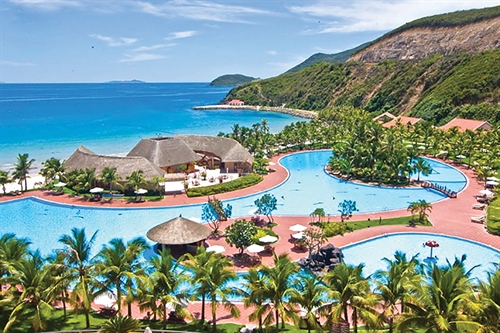 |
| Vinpearl Nha Trang Resort in Hon Tre islet__Photo: https://vinpearlresortvietnam.com/ |
For marine resource farming and exploitation, to change the marine resource farming and exploitation by traditional methods to industrial ones with the application of high technologies. To reorganize marine product exploitation activities toward reducing coastal fishing and stepping up offshore and ocean fishing suitable to each sea area and the recoverability of marine eco-systems in couple with the synchronous and effective training and occupation change for fishermen. To promote the sustainable marine resource farming and exploitation, intensifying the protection and regeneration of marine resources, strictly prohibiting overfishing activities. To modernize the on-sea fishery management; to step up production alignment in forms of cooperation teams, cooperatives or unions of cooperatives; to build strong enterprises for participation in offshore fishing and cooperation in ocean fishing. To invest in upgrading fishing ports, fishing wharves, anchoring and mooring zones, and well organize fishery logistics services. To step up the application of science and advanced technologies to marine resource farming, exploitation, preservation and processing, creating key products of high quality and economic value, satisfying market demands.
For coastal industries, to develop in accordance with planning, taking into account the natural condition advantages of each region, prioritizing the development of environment-friendly hi-tech industries, base industries and source industries. To rationally develop ship-repairing and -building as well as petro-chemical, mechanical engineering, processing and supporting industries.
For renewable energy and new marine economic sectors, to promote investment in the construction and exploitation of wind power, solar power and other forms of renewable energy in accordance with the National Electricity Development Master Plan for the 2021-30 period (Power Master Plan VIII). To develop the equipment manufacturing industry in service of the renewable energy industry, proceeding to master a number of equipment-designing and -manufacturing technologies; to prioritize investment in the development of renewable energies on islands to serve production and daily-life activities, defense and security maintenance. To attach importance to the development of a number of industries based on the exploitation of bio-diversity resources such as marine pharmaceutical, seaweed planting and processing.
Developing a blue economy is a correct option to the effective and sustainable development of the sea economy towards industrialization and modernization. Therefore, this requires that development of marine economic sectors should shift from the exploitation and polluting economy to a blue economy, investing in the organic connection chains from the mainland to the sea, reducing the polluting sources right from the mainland.
It is necessary to formulate and improve mechanisms and policies in support of comprehensive coastal management, transforming the economy towards developing a blue economy. To incorporate the objectives of comprehensive coastal management and initiatives of development of a blue economy in the strategies and plans on socio-economic development of sea and coastal regions to deal with newly arising challenges in the management of marine resources and environment.
To step up the attraction of resources from various economic sectors, particularly private and foreign-invested enterprises; to proactively attract major investors with source technologies, advanced management level from developed countries in the development of a blue economy. To prioritize the state budget investment in the development of frontline offshore island districts and communes; to socialize the investment in marine infrastructures, islands, coastal economic zones and industrial parks. To encourage the development of enterprises of all economic sectors, strong marine economic groups carrying out production and business activities on the sea, especially in offshore and oceanic areas. To further restructure state enterprises in the marine economic sectors, ensuring their higher governance capability, production and business efficiency and competitiveness.-
